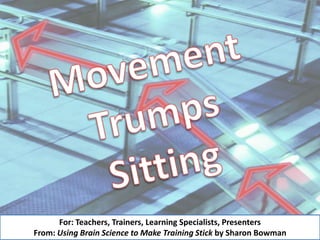Movement Trumps Sitting
- 1. For: Teachers, Trainers, Learning Specialists, Presenters From: Using Brain Science to Make Training Stick by Sharon Bowman
- 3. The Question:
- 4. Who moves the ?
- 5. Here?
- 6. Here? Here?
- 7. Here? Here? Here?
- 9. YouŌĆÖre right! Way to go!
- 10. And who should move the ?
- 11. Right again: The learners. Two for two!
- 15. because ŌĆ”
- 21. How can learners move more while spending time here ???
- 22. Simple!
- 24. standing sitting
- 26. watching talking
- 28. writing reading
- 31. learn better and remember more
- 32. and that is a very good thing. (especially before a test)
- 36. (especially before a test)
- 37. (especially before a test)
- 42. Stand, Stretch, and Speak Body Break #1
- 43. You say to the learners: Stand and stretch your arms, legs, and body. Then tell your table group (or those around you) what you have learned and how you plan to apply it to what you do. Time: about one minute.
- 44. Bend, Breathe, and Write Body Break #2
- 45. You say to the learners: Drop your pen or pencil on the floor. When you bend down to pick it up, forcefully blow all the air out of your lungs. When you straighten up, take a deep breath, inhaling as much air as you can. Then write a brief summary of the main facts presented so far. Time: about one minute.
- 46. Body Break #3
- 47. You say to the learners: Turn to the person seated nearest you (make sure no one is left out) and tell that person the three most important facts youŌĆÖve learned from the content so far. Time: about one minute.
- 49. Body Break #4
- 50. You say to the learners: Stand and find one or two friends to walk with. Walk around the perimeter of the room and talk about how you plan to use what you have learned. When you get back to where you began, thank your walkabout group. Time: about three minutes.
- 51. Pop Quiz!
- 52. 1. A lot of cute animals. 2. Movement, oxygen, the brain and learning. 3. Body breaks and apple pie.
- 53. 2. Movement, oxygen, the brain and learning.
- 54. 1. About every hour of class time. 2. About every 10 ŌĆō 20 minutes of class time.
- 55. 2. About every 10 ŌĆō 20 minutes of class time.
- 56. 2. About every 10 ŌĆō 20 minutes of class time. Use the 10-minute rule. What is THAT?
- 57. ŌĆ£Before the first quarter-hour is over in a typical presentation, people usually have checked out. What happens at the ten-minute mark to cause such trouble? ŌĆ” The brain seems to be making choices according to some stubborn timing pattern, undoubtedly influenced by both culture and gene.ŌĆØ John Medina, Brain Rules, 2008, p.74
- 58. They need to DO something: write, talk, stand, stretch.
- 59. Who? Me?
- 60. Get this and one of these. Yes, you.
- 61. Do this: Put your hands on your head, lean back, and inhale deeply. Then take the Post-It note and pencil. Write down what you plan to do with what youŌĆÖve learned from this presentation. Your body and brain will thank you.
- 62. Put your Post-It note here so you wonŌĆÖt forget to do it. Your learners will thank you too.
- 63. Content from: Using Brain Science to Make Training Stick! Author: Sharon Bowman ┬® 2011 All rights reserved. For book purchases, log onto www.amazon.com
- 65. More books by Sharon Bowman


































































